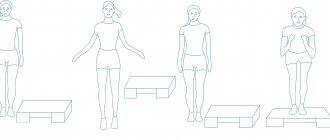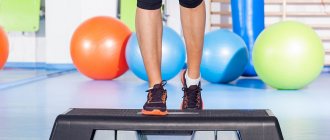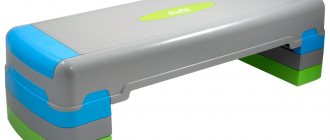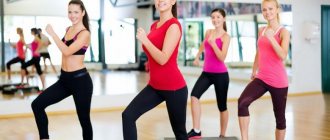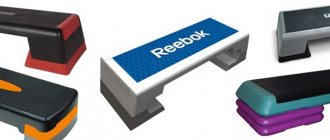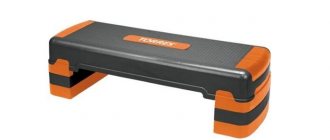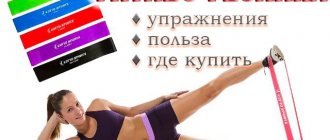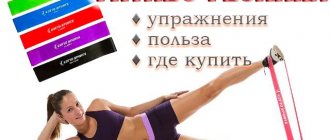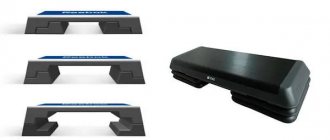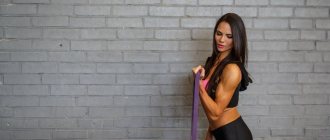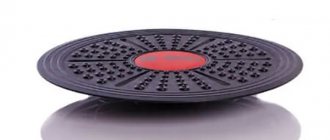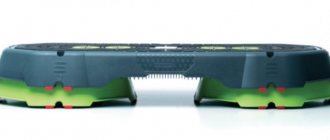A step platform is a sports equipment that is a small bench with an adjustable height level. This platform is designed not only for step aerobics, but also for performing strength and cardio exercises. Most often, this sports equipment is made of special plastic and has a corrugated surface that prevents slipping during exercise.
The step platform is a truly versatile fitness equipment. You can do aerobics with it, perform strength and plyometric exercises, complicate and simplify classic exercises. In general, using this equipment will help you create an effective set of exercises for losing weight and strengthening the muscles of the whole body, especially the legs and buttocks.
Step platform: what is it for?
1. Most often, a step platform is used at home for step aerobics. Step aerobics is one of the most effective types of low-impact cardio for burning calories and fat. More about this: Step aerobics: benefits, harm, exercises and videos.
2. You will need a step platform during strength exercises that require a bench. For example, if you perform a dumbbell chest press on the floor, you will not be able to lower your elbows low enough, which means the exercise will not be performed with sufficient amplitude and efficiency:
Or, for example, to perform a Bulgarian lunge you also need a step platform:
3. Some exercises are easier to do with emphasis on the step platform than with emphasis on the floor. For example, push-ups and planks. Therefore, the step platform will be useful for those who are just learning to do push-ups or want to simplify any exercises that rely on their hands.
4. The platform can be used to perform jumping exercises, in which you need to jump onto some height. Usually a special stand is used for jumping, but you can also jump onto a step platform (the main thing is that it is stable!):
5. The step platform is an almost ideal piece of equipment for training the lower body. Moreover, with the step you will work specifically on reducing the volume of the hips, forming slender, toned legs.
6. The step platform is useful for performing various modifications of classic exercises. This will help you greatly diversify your workouts:
As you can see, everyone can find a use for the step platform in home fitness. This functional equipment will really come in handy when performing both strength and cardio exercises. And if, in addition to everything else, you love step aerobics, then it’s definitely worth purchasing a platform for home exercises.
Benefits of the step platform:
- If you have a platform, you can do step aerobics at home - this is a very effective low-impact type of training for weight loss.
- The step platform is convenient for performing strength exercises with dumbbells - it replaces a sports bench.
- The step platform will help you complicate any cardio workout by adding more intense jumping exercises (a selection of exercises below).
- Exercises with a step platform will give additional stress to the muscles of the buttocks and legs, which is especially important for girls.
- A step platform will simplify many exercises that focus on your arms: doing push-ups and standing in a plank position on a small hill is much easier.
Recommendations and contraindications for step aerobics
Step aerobics as a method of exercise for people suffering from obesity has proven its effectiveness: reducing total body weight and fat mass; improvement of muscle tone; reducing stress on joints; improving cardiovascular health. Step is contraindicated when recovering from traumatic effects on the body, as well as when suffering a heart attack or stroke.
Stepping is the preferred exercise method for anyone looking to lose maximum weight or improve overall fitness.
How to choose a step platform?
Since the fashion for fitness and a healthy lifestyle is only gaining momentum every year, the choice of sports equipment in stores is truly enormous. How to choose a step platform for training at home and what to look for when buying? There are several criteria that are important to keep in mind when purchasing a step platform. Let's look at them in more detail.
Length and width of the step platform
For comfortable training, we recommend focusing on the following parameters of the step platform:
- Length : from 80 cm (so that you can place your feet shoulder width apart)
- Width : 35-41 cm (length of your foot + a few centimeters)
In the inexpensive price segment there are step platforms that are shorter in length. For example, the StarFit SP102 model, its dimensions are 72 x 36.5:
With such a length of surface, it will be uncomfortable to exercise, you will not feel freedom of movement and even risk falling. Therefore, it is better not to purchase platforms with a short length.
Choose the width based on the size of your feet. For example, the length of the foot in size 38 is 25 cm. Plus add a few centimeters that fall on the sneakers, and a little reserve space in front and behind for comfortable activities. Accordingly, the width of the step platform should be at least 35 cm.
Height and number of levels
The height of the step platform is 10-25 cm, it has several levels. Each level adds 5 cm. Usually there are two-level and three-level step platforms. According to studies, each level provides an additional 12% of the load. Example of a two-level and three-level step platform (models StarFit SP102 and StarFit SP201):
For beginners, a height of 10 cm is enough for training - the minimum level of the step platform. Advanced people can practice at a level of 20-25 cm.
Strength and shock absorption qualities
Typically, the characteristics of a step platform indicate the maximum weight that the surface can support (100-130 kg). Moreover, it is worth considering not only your own weight, but also the weight of dumbbells and barbells if you plan to exercise with them. Check the projectile for strength: the surface should not spring or sag when jumping. High-quality, durable step platforms weigh at least 8 kg.
As a rule, more expensive platforms have plastic that has better shock-absorbing characteristics, thanks to which the impact of the feet on the surface is absorbed. The health of your joints and spine depends on this, so you should not neglect this parameter.
Surface
For the safety of your activities, pay attention to whether there is a rubber coating on the surface of the step. On budget projectiles, manufacturers can limit themselves to a ribbed surface, but it is better to give preference to rubber-coated platforms. The supports of the step platform must also be stable and not slip.
Support design
There are 2 types of step platforms: collapsible and reconfigurable. As a rule, collapsible platforms have a length of 20 cm, and platforms with legs rise up to 25 cm. For example, compare the StarFit SP-201 and Reebok RSP-16150 models:
In the first case, you can additionally purchase supports if you need to increase the height of the projectile. However, it is safer to use reconfigurable supports, since the removable parts may simply fly apart when jumping. This is how the reconfigurable platform works:
We do not recommend constructing step platforms at home. Firstly, manufacturers of sports goods make them from special plastic, which absorbs the impact load at the moment the foot comes into contact with the surface of the platform. This helps keep your joints and spine healthy. Secondly, the step platform must be stable and have a rubberized surface, and this is also difficult to do at home.
Also try not to purchase a used step platform. There is a risk that there will be kinks and cracks on the surface that you will not notice behind the rubberized coating.
Reebok Step Platforms
Reebok step platforms are more expensive, but they are also of the best quality. If you have the financial opportunity, it is better to purchase a Reebok step platform. Firstly, Reebok platforms are comfortable and safe to work with. Secondly, their service life is quite long.
Functional training
Functional training is a training process that aims to develop the basic functions of the body: endurance, speed, coordination, flexibility and agility. When drawing up a training program, the current physical condition is first taken into account.
The exercises are aimed at the stabilizer muscles that hold the body in certain positions. They are located deep in the muscular system and are very difficult to work out during regular training - aerobic or strength training.
Functional training strengthens the entire muscular system, especially the muscles of the lower back and abdomen. Posture, sense of balance, control over movements, overall endurance and body tone gradually improve. Initially, these exercises were invented for professional athletes. For example, they help figure skaters achieve a confident step and excellent coordination, and sprinters help them make the most effective push at the start.
Circular functional training is considered more effective and complex, when the exercises are performed one after another, without a break. At the same time, in all exercises different muscle groups are involved, and as a result the load falls on the whole body. With this approach, endurance and coordination are even better developed.
According to many trainers, functional training for women and men has not only a general strengthening effect, but a specific health effect: with their help you can get rid of headaches, reduce the manifestations of osteochondrosis and scoliosis.
Functional endurance training is carried out with your own weight. However, additional equipment can be used - weights, step platform, elastic bands and shock absorbers.
Types of functional training
- Base. Exercises with your own weight without the use of additional equipment, suitable for beginners, people without physical training or athletes after a long break, to regain shape.
- TRX (Total Body Resistance Exercises) Exercises with your own weight and the use of special trx loops - these are two slings that are connected to each other and secured at a certain height.
- Core. Bodyweight training on a special unstable platform. Referred to as a speed-strength type of fitness, it combines cardio and strength training for all muscle groups.
- Bosu. Bodyweight exercises using a hemispherical platform. The load level can be adjusted by changing its elasticity.
- CrossFit. Here basic exercises are performed with free weights (dumbbells, kettlebells, barbells). Not recommended for beginners.
- Workout. Performing exercises outdoors using horizontal bars, ladders, parallel bars, etc.
Functional training exercises
Functional exercises are selected depending on your level of training, and they can be done both in the gym and at home.
Lunges
This exercise provides functional training for the legs and buttocks, but also improves coordination and stability and has a beneficial effect on ligaments and joints. Lunges are widely used in fitness - both among bodybuilders and among women who want to have beautiful thighs.
Lunge technique:
- Stand in the starting position: back straight, shoulder blades pulled together, arms along the body, feet hip-width apart.
- Take the largest step forward as you inhale, while keeping your body straight.
- Shift your body weight to your forward leg. In this case, the thigh of the front leg should be parallel to the floor, and the knee of the back leg should almost touch the floor. In this position, the muscles of the back leg should be tense.
- Hold your breath for a few seconds.
- Return to the starting position, repeat the same with the other leg, do the required number of repetitions.
Squats
Squats are used in bodybuilding, choreography and physical therapy. They strengthen the muscles of the legs, buttocks, back and abs, and improve coordination. In everyday life, exercise makes it easier to sit down and stand up, and pick up objects from the floor.
Technique:
- Take the starting position: your shoulders are pulled back and lowered, your back is straight, your legs are slightly wider than your shoulders, your arms are extended forward with your palms down, folded behind your head, fixed with your palms at your waist or bent at the elbows and pressed to your torso.
- Push your hips back slightly and gradually bend your knees. In this case, the back should remain straight throughout the squat, and the knees should not go forward beyond the line of the toes. Move your pelvis back as if sitting on a chair.
- If you are new to this exercise, do not squat deeply: stop in a position parallel to the floor. The deeper the squat, the more effective it is.
- In the final position, transfer your weight to your heels.
- Return to the starting position and complete the required number of repetitions.
Climbing onto the step platform
This exercise teaches you how to climb stairs quickly and easily. Develops coordination and stability, strengthens joints, muscles of the legs, buttocks, abdomen and back. Instead of a step platform, you can use a bench, but in this case you will not be able to adjust the lifting height.
Technique:
- Stand exactly in front of the step platform, at a distance of 30–40 cm from it, place your feet shoulder-width apart.
- Fold your arms across your chest or along your body, relax your shoulders, and straighten your back.
- As you inhale, place one foot on the step platform and, using the efforts of your front leg, bring the other one to it.
- Return to the starting position. In this case, the descent must be controlled by the efforts of the leg that stands on the platform.
- Complete the required number of repetitions.
- You can do the exercise first on one leg, then on the other, or you can alternate. All movements should be slow. If you can't maintain your balance, try shortening your stride.
You can do the exercise first on one leg, then on the other, or you can alternate. All movements should be slow. If you can't maintain your balance, try shortening your stride.
Pull
For this exercise you will need an resistance band. Stretching has a beneficial effect on the muscles of the back and arms - you can easily open heavy doors.
Technique:
- Take the starting position: sit on the floor, bend your knees, place your feet shoulder-width apart. Wrap the tape around your feet, take the free ends in your hands and turn your palms towards you.
- Pull the band toward you until your arms are above your waist. In this case, the elbows should be pressed to the body.
- As you inhale, slowly return to the starting position.
- Depending on your physical fitness, you should determine how long the approach will last: normally from 30 to 60 seconds.
Spin with the ball
The exercise is aimed at improving coordination and strengthening muscles. You begin to feel your body better, develop dexterity and coordination.
Technique:
- Kneel down, bend your left leg at a right angle, place your foot firmly on the floor and press your right knee to the floor.
- Take the ball in both hands and lift it above your head. At the same time, additionally tighten the muscles of the thighs, abdomen and chest. Move your hands to your right thigh and hold this pose for a moment.
- Return to the starting position.
- Repeat the same exercise, but with your right leg forward and leaning toward your left hip.
- Do the required number of repetitions.
- Lunges, squats, and step-up exercises can be done not only with your own weight, but also with dumbbells, barbells, and weights. This provides additional load and increases efficiency.
A group or personal trainer may suggest other functional training exercises, including push-ups, pull-ups, deadlifts, burpees, etc. It all depends on the specific program and your fitness level.
Functional training program for beginners
Here are exercises for functional training that are suitable for beginners of any gender. Let's figure out what exercises are performed in the gym and how they can be replaced at home. It is recommended to perform the training program 3-4 times a week.
Functional training for men
Each workout lasts at least an hour and begins with a warm-up. Next, sets of exercises are performed.
The first day
- 15 pull-ups hanging on the bar.
- 10 squats.
- 12 burpees.
- A minute of jumping rope.
- Two minutes of fast running.
It is recommended to perform the complex for 15 minutes, then stop for 1 minute and repeat the exercises.
Second day
- 15 squats.
- 15 dips.
Perform 2-3 sets with 1-2 minutes rest.
Day three
- 20 jumps onto the step platform.
- 15 pull-ups on the bar.
- 15 squats.
- 24 lunges - 12 for the right leg and 12 for the left.
Perform the exercises for 15 minutes, then rest for 1 minute and repeat. Finish with 50 side crunches, 25 on each side.
Day four
- 12 push-ups.
- Deadlift with light weight - 10 reps.
- Overhead barbell pushes - 10 reps.
- Hyperextension without weight - 10 reps.
- Kettlebell swings - 10 reps.
- 3 minutes of running in place.
This complex must be repeated 3 times, then do the following complex 2 times: 25 hanging leg raises and 25 straight crunches.
Day five
- 10 push-ups.
- 10 pull-ups.
Repeat the complex 5 times.
Next, you need to continue training according to the same scheme, but increase the load each time: take more weight or perform more repetitions.
How to replace exercises at home
Not all exercises from this program can be replaced, especially if you do not have additional equipment. The complex will be effective if you have a horizontal bar, as well as dumbbells or kettlebells. In this case, all manipulations with the barbell, including deadlifts, can be replaced with exercises with weights/dumbbells.
Instead of dips, you can use reverse push-ups. If there is no bench, off the floor. Instead of hyperextension, perform the classic “boat” exercise. Instead of jumping rope, do regular jumping.
Functional training for women
This program was created for weight loss. It also increases endurance, improves joint mobility and overall health of the body, especially the cardiovascular system. In addition, with the help of such functional training you can “dry” your muscles and achieve ideal shape.
The first day
Starts with cardio - 10 minutes. The following is a set of exercises:
- 5 pull-ups.
- 12 push-ups.
- 12 squats without weight.
Perform the complex in a circle for 10 minutes, then take a break for 1 minute and go to the next circle.
Second day
It starts with a cardio warm-up - 15 minutes. Then you need to perform the following complex:
- 15 lunges on each leg.
- 15 push-ups.
- 10 lunges.
- 10 push-ups.
- 7 lunges.
- 7 push-ups.
The circle must be repeated five times, resting for a minute between circles.
Day three
It begins with warming up the joints, which takes from 5 to 7 minutes. Next you need to perform two rounds of exercises.
- The first lap is a minute of intense running, a minute of rest. Repeat five times.
- Second circle - 10 push-ups, 7 lunges, 7 steps on a step or bench. Repeat five times with a rest of 60 seconds.
Finally, do some stretching.
